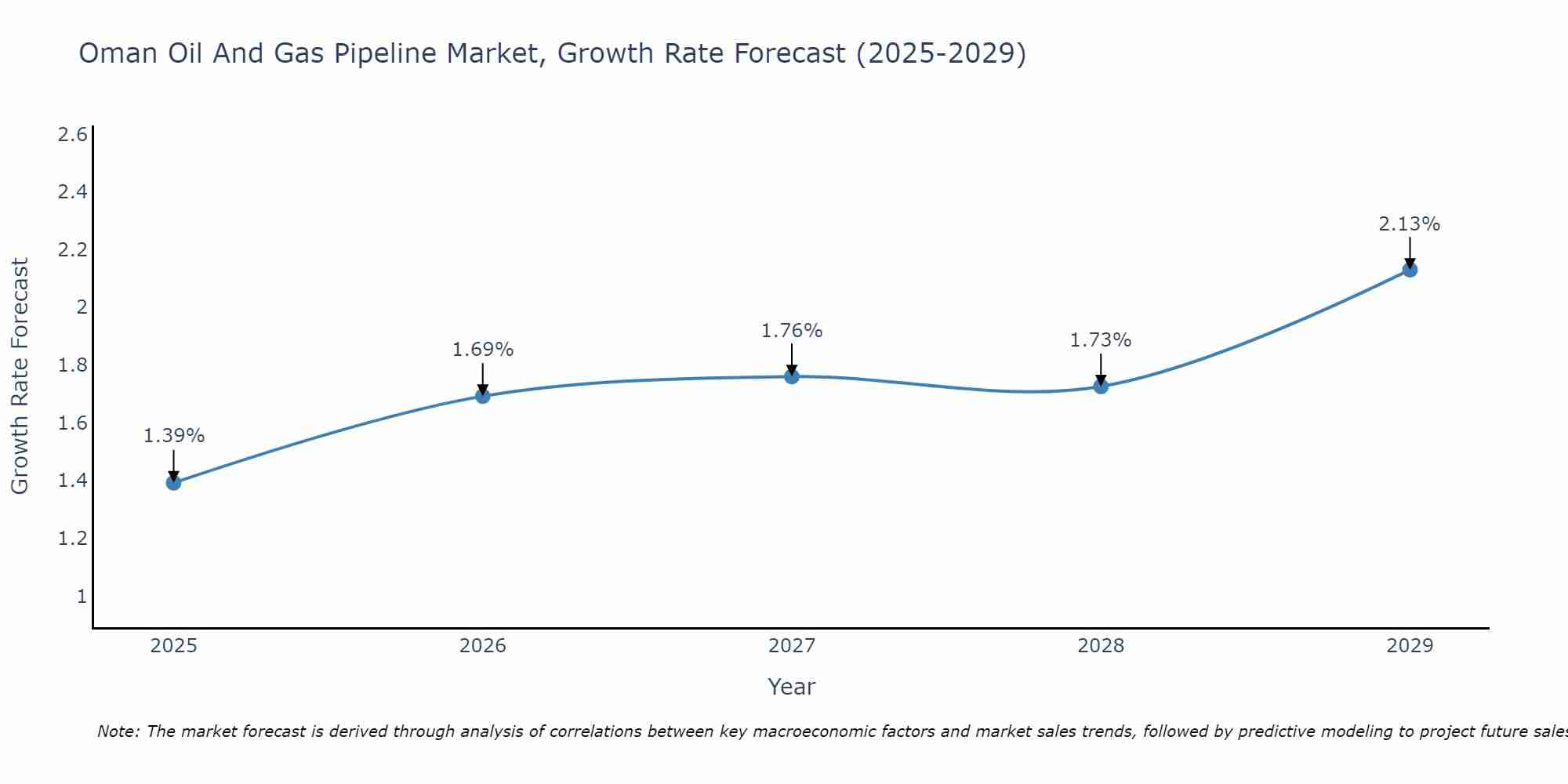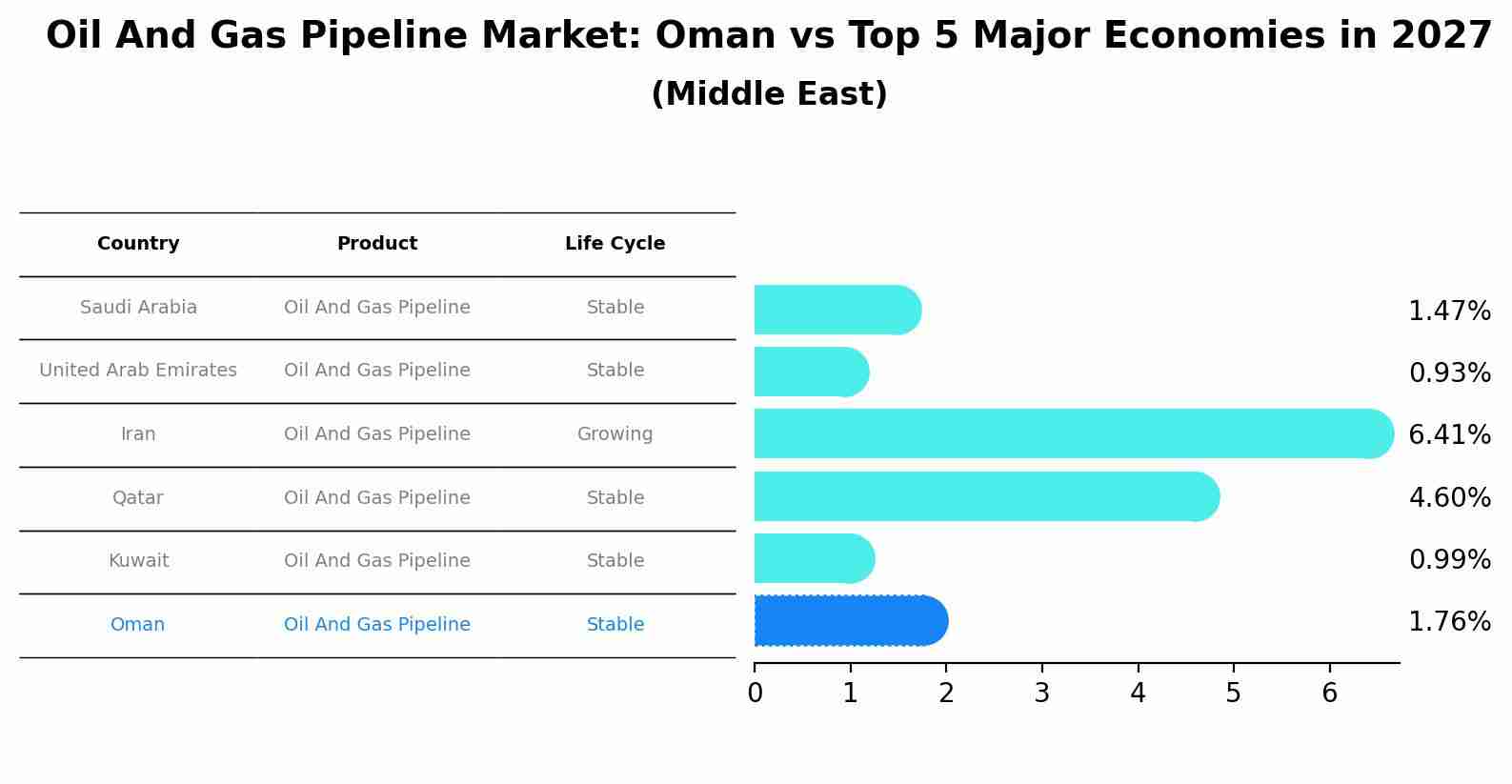Oman Oil And Gas Pipeline Market Outlook | Trends, COVID-19 IMPACT, Growth, Industry, Share, Forecast, Revenue, Size, Companies, Analysis & Value
| Product Code: ETC377323 | Publication Date: Aug 2022 | Updated Date: Jul 2025 | Product Type: Market Research Report | |
| Publisher: 6Wresearch | Author: Vasudha | No. of Pages: 75 | No. of Figures: 35 | No. of Tables: 20 |
Oman Oil And Gas Pipeline Market Size Growth Rate
The Oman Oil And Gas Pipeline Market is projected to witness mixed growth rate patterns during 2025 to 2029. The growth rate starts at 1.39% in 2025 and reaches 2.13% by 2029.

Oil And Gas Pipeline Market: Oman vs Top 5 Major Economies in 2027 (Middle East)
In the Middle East region, the Oil And Gas Pipeline market in Oman is projected to expand at a stable growth rate of 1.76% by 2027. The largest economy is Saudi Arabia, followed by United Arab Emirates, Iran, Qatar and Kuwait.

Oman Oil And Gas Pipeline Market Synopsis
The Oman oil and gas pipeline market is experiencing steady growth driven by increasing investments in the country`s oil and gas infrastructure. The market is primarily driven by the need to transport oil and gas products efficiently and cost-effectively across the country. Major players in the market are expanding their pipeline networks to meet the growing demand for oil and gas transportation. Additionally, the government`s initiatives to enhance the country`s energy infrastructure and promote oil and gas exports are further fueling market growth. Technological advancements in pipeline construction and maintenance are also contributing to the market`s development. Overall, the Oman oil and gas pipeline market is expected to continue its positive trajectory in the coming years, offering opportunities for both domestic and international pipeline companies.
Oman Oil And Gas Pipeline Market Trends
The Oman Oil and Gas Pipeline Market is witnessing several key trends. One prominent trend is the increasing investment in pipeline infrastructure to support the country`s growing oil and gas production and export capabilities. Another trend is the focus on pipeline integrity and maintenance to ensure safe and efficient operations. Additionally, there is a growing shift towards the use of advanced technologies such as smart pipeline monitoring systems and digital solutions to optimize pipeline performance and reduce operational costs. Furthermore, there is a rising emphasis on environmental sustainability, leading to the adoption of cleaner energy sources and more efficient pipeline transportation methods. Overall, these trends indicate a shift towards modernization, efficiency, and sustainability in the Oman Oil and Gas Pipeline Market.
Oman Oil And Gas Pipeline Market Challenges
The Oman Oil and Gas Pipeline Market faces several challenges, including geographic constraints due to rugged terrain and remote locations, which can increase construction costs and project timelines. Additionally, the market is impacted by fluctuating oil prices and geopolitical uncertainties, affecting investment decisions and project viability. Regulatory hurdles and compliance requirements also pose challenges in terms of obtaining permits and approvals for pipeline projects. Furthermore, the industry`s reliance on traditional fossil fuels raises concerns about sustainability and environmental impact, leading to potential resistance from local communities and environmental groups. Overall, addressing these challenges requires a comprehensive approach that considers technological advancements, stakeholder engagement, and strategic planning to ensure the sustainable development of the Oman Oil and Gas Pipeline Market.
Oman Oil And Gas Pipeline Market Investment Opportunities
The Oman oil and gas pipeline market presents several investment opportunities for both domestic and foreign investors. With the government`s focus on expanding and modernizing the country`s energy infrastructure, there is a growing demand for new pipeline projects to transport oil and gas resources efficiently. Investing in the construction and development of pipelines, as well as maintenance and upgrade services, can provide steady returns in the long term. Additionally, the strategic location of Oman as a gateway between the Gulf region and Asia makes it an attractive hub for energy transportation, further enhancing the investment potential in the pipeline sector. Collaborating with local companies or forming partnerships with established players in the industry can also offer access to valuable expertise and opportunities in the Oman oil and gas pipeline market.
Jordan Agar Market Government Policies
The Oman government has implemented several policies related to the oil and gas pipeline market aimed at enhancing infrastructure development and attracting foreign investment. These policies include the establishment of the Oman Gas Company (OGC) to oversee the gas pipeline network and ensure efficient distribution. Additionally, the government has introduced incentives such as tax breaks and subsidies to encourage the expansion of pipeline projects and promote collaboration with international partners. Furthermore, Oman has focused on diversifying its energy sources and reducing reliance on traditional oil exports by investing in natural gas pipelines and renewable energy projects. Overall, the government`s policies aim to modernize the oil and gas pipeline sector, strengthen energy security, and stimulate economic growth in Oman.
Oman Oil And Gas Pipeline Market Future Outlook
The Oman Oil and Gas Pipeline Market is poised for steady growth in the coming years due to increasing energy demand and the government`s focus on infrastructure development. The market is expected to benefit from the ongoing investment in pipeline projects to enhance the country`s energy transportation capabilities and reduce reliance on traditional methods of transportation. Additionally, the discovery of new oil and gas reserves in Oman will likely drive further pipeline infrastructure development to facilitate the transportation of these resources. The market is also anticipated to witness technological advancements in pipeline construction and maintenance, improving efficiency and safety standards. Overall, the future outlook for the Oman Oil and Gas Pipeline Market appears promising, with sustained growth opportunities on the horizon.
Key Highlights of the Report:
- Oman Oil And Gas Pipeline Market Outlook
- Market Size of Oman Oil And Gas Pipeline Market, 2021
- Forecast of Oman Oil And Gas Pipeline Market, 2031
- Historical Data and Forecast of Oman Oil And Gas Pipeline Revenues & Volume for the Period 2018 - 2031
- Oman Oil And Gas Pipeline Market Trend Evolution
- Oman Oil And Gas Pipeline Market Drivers and Challenges
- Oman Oil And Gas Pipeline Price Trends
- Oman Oil And Gas Pipeline Porter's Five Forces
- Oman Oil And Gas Pipeline Industry Life Cycle
- Historical Data and Forecast of Oman Oil And Gas Pipeline Market Revenues & Volume By Location of Deployment for the Period 2018 - 2031
- Historical Data and Forecast of Oman Oil And Gas Pipeline Market Revenues & Volume By Onshore for the Period 2018 - 2031
- Historical Data and Forecast of Oman Oil And Gas Pipeline Market Revenues & Volume By Offshore for the Period 2018 - 2031
- Historical Data and Forecast of Oman Oil And Gas Pipeline Market Revenues & Volume By Type for the Period 2018 - 2031
- Historical Data and Forecast of Oman Oil And Gas Pipeline Market Revenues & Volume By Crude Oil Pipeline for the Period 2018 - 2031
- Historical Data and Forecast of Oman Oil And Gas Pipeline Market Revenues & Volume By Gas Pipeline for the Period 2018 - 2031
- Oman Oil And Gas Pipeline Import Export Trade Statistics
- Market Opportunity Assessment By Location of Deployment
- Market Opportunity Assessment By Type
- Oman Oil And Gas Pipeline Top Companies Market Share
- Oman Oil And Gas Pipeline Competitive Benchmarking By Technical and Operational Parameters
- Oman Oil And Gas Pipeline Company Profiles
- Oman Oil And Gas Pipeline Key Strategic Recommendations
Frequently Asked Questions About the Market Study (FAQs):
- Single User License$ 1,995
- Department License$ 2,400
- Site License$ 3,120
- Global License$ 3,795
Search
Thought Leadership and Analyst Meet
Our Clients
Related Reports
- Canada Oil and Gas Market (2026-2032) | Share, Segmentation, Value, Industry, Trends, Forecast, Analysis, Size & Revenue, Growth, Competitive Landscape, Outlook, Companies
- Germany Breakfast Food Market (2026-2032) | Industry, Share, Growth, Size, Companies, Value, Analysis, Revenue, Trends, Forecast & Outlook
- Australia Briquette Market (2025-2031) | Growth, Size, Revenue, Forecast, Analysis, Trends, Value, Share, Industry & Companies
- Vietnam System Integrator Market (2025-2031) | Size, Companies, Analysis, Industry, Value, Forecast, Growth, Trends, Revenue & Share
- ASEAN and Thailand Brain Health Supplements Market (2025-2031) | Strategy, Consumer Insights, Analysis, Investment Trends, Opportunities, Growth, Size, Share, Industry, Revenue, Segments, Value, Segmentation, Supply, Forecast, Restraints, Outlook, Competition, Drivers, Trends, Demand, Pricing Analysis, Competitive, Strategic Insights, Companies, Challenges
- ASEAN Bearings Market (2025-2031) | Strategy, Consumer Insights, Analysis, Investment Trends, Opportunities, Growth, Size, Share, Industry, Revenue, Segments, Value, Segmentation, Supply, Forecast, Restraints, Outlook, Competition, Drivers, Trends, Demand, Pricing Analysis, Competitive, Strategic Insights, Companies, Challenges
- Europe Flooring Market (2025-2031) | Outlook, Share, Industry, Trends, Forecast, Companies, Revenue, Size, Analysis, Growth & Value
- Saudi Arabia Manlift Market (2025-2031) | Outlook, Size, Growth, Trends, Companies, Industry, Revenue, Value, Share, Forecast & Analysis
- Uganda Excavator, Crane, and Wheel Loaders Market (2025-2031) | Strategy, Consumer Insights, Analysis, Investment Trends, Opportunities, Growth, Size, Share, Industry, Revenue, Segments, Value, Segmentation, Supply, Forecast, Restraints, Outlook, Competition, Drivers, Trends, Demand, Pricing Analysis, Competitive, Strategic Insights, Companies, Challenges
- Rwanda Excavator, Crane, and Wheel Loaders Market (2025-2031) | Strategy, Consumer Insights, Analysis, Investment Trends, Opportunities, Growth, Size, Share, Industry, Revenue, Segments, Value, Segmentation, Supply, Forecast, Restraints, Outlook, Competition, Drivers, Trends, Demand, Pricing Analysis, Competitive, Strategic Insights, Companies, Challenges
Industry Events and Analyst Meet
Whitepaper
- Middle East & Africa Commercial Security Market Click here to view more.
- Middle East & Africa Fire Safety Systems & Equipment Market Click here to view more.
- GCC Drone Market Click here to view more.
- Middle East Lighting Fixture Market Click here to view more.
- GCC Physical & Perimeter Security Market Click here to view more.
6WResearch In News
- Doha a strategic location for EV manufacturing hub: IPA Qatar
- Demand for luxury TVs surging in the GCC, says Samsung
- Empowering Growth: The Thriving Journey of Bangladesh’s Cable Industry
- Demand for luxury TVs surging in the GCC, says Samsung
- Video call with a traditional healer? Once unthinkable, it’s now common in South Africa
- Intelligent Buildings To Smooth GCC’s Path To Net Zero


















